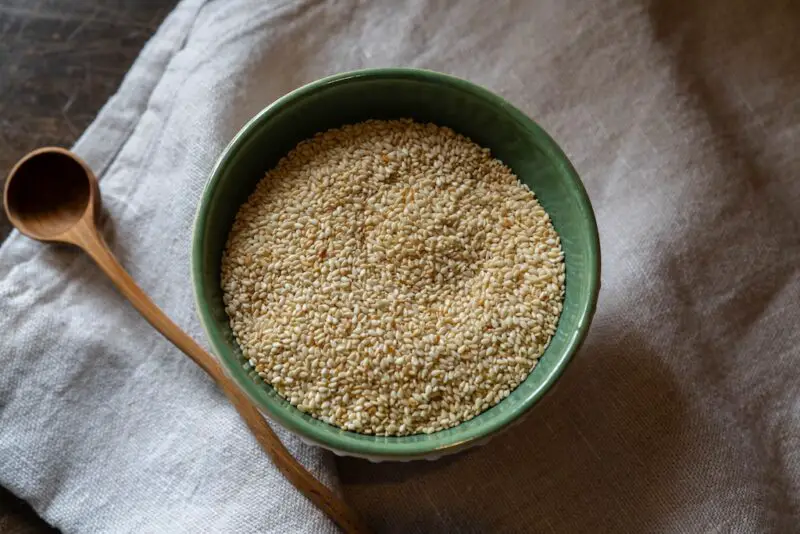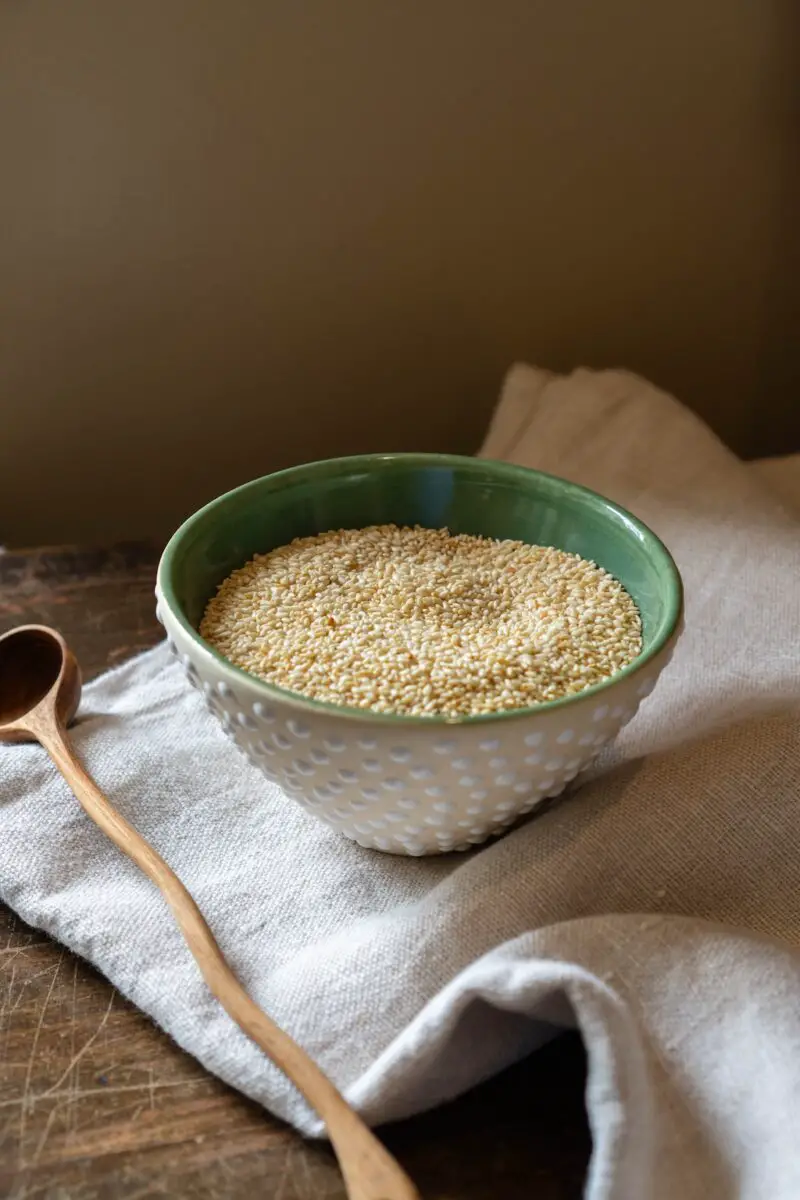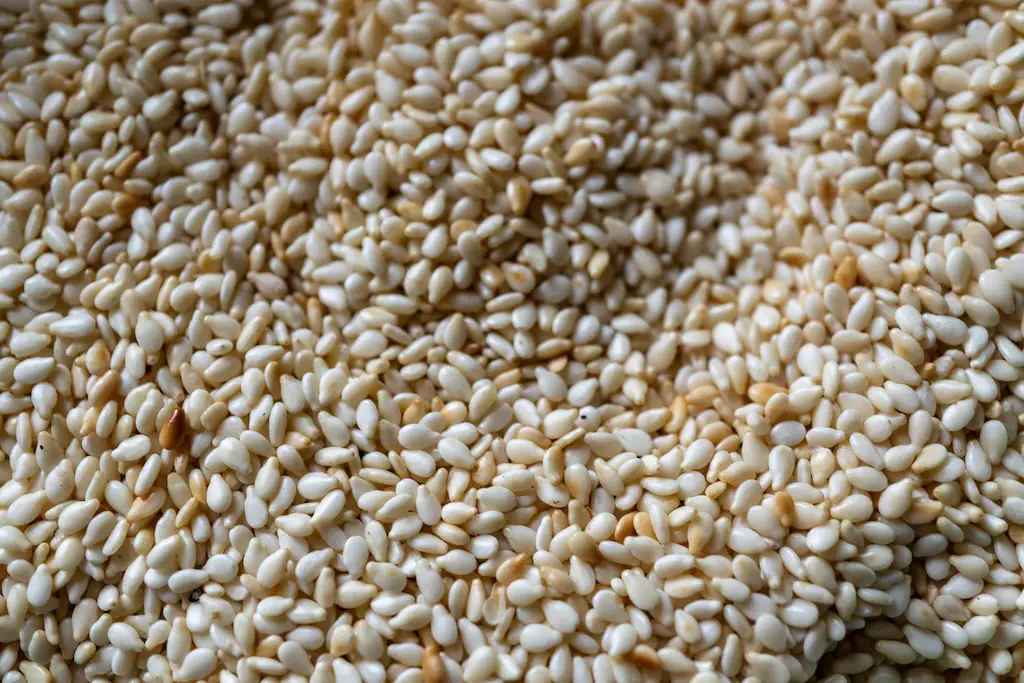This post may contain affiliate links. Please read my disclosure for details at the bottom of this page. As an Amazon Associate, I earn from qualifying purchases on this article about cham-kkae, otherwise known as sesame seeds. We hope you enjoy learning about sesame seeds in Korean cooking!
Published 03/03/2022 Updated 07/10/2025
Have you ever eaten in a Korean restaurant or made Korean food at home? If so, you may have noticed people often finish Korean dishes with a sprinkle of toasted sesame seeds. Sesame seeds add a rich, nutty, and warm flavor when used as a seasoning ingredient.
Many of our recipes use sesame seeds (and/or sesame oil) as a finisher to the dish. Here, we want to introduce sesame seeds for those interested in Korean cooking. But, before getting to sesame seeds in Korean culture, let’s learn what they are first!
What Are Sesame Seeds?
Sesame seeds are the seeds of the sesame flowering plant in the genus Sesamum, otherwise known as benne.
While most wild species of Sesamum are native to sub-Saharan Africa, S. Indicum, the domesticated and cultivated type, emerged in India. These seeds are one of the oldest known oilseed crops in the world with documented domestication dating back well over 3,000 years. Some archaeological remnants may suggest that sesame was first domesticated approximately 5,500 years ago in the Indian subcontinent. Interestingly, sesame may have emerged as a crop because of its ability to grow and prosper in areas unsuitable for the growth of other crops.
Not only are the seeds used to sprinkle raw or tasted over foods, but they are also used to produce sesame oil, which has one of the highest oil contents of any seeds.
While the most traded and consumed type of sesame is slightly creamy off-white, other sesame varieties come in gold, brown, reddish-brown, black, buff, gray, and even tan. Typically, the color of the hull is the same as the fruit!
Now that we learned about this ingredient, let’s learn about how they are used in Korean cooking!

Sesame Seeds in Korean Culture:
In the Korean language, the term for raw sesame seeds is ‘cham-kkae’ (참깨).
In South Korea, people use different forms of these seeds in cooking! I list them below:
- Tong Kkae (통깨): Whole sesame seeds
- Bokkeun Kkae (볶은깨) or Bokkeun Chamkkae (볶음 참깨): Roasted sesame seeds
- Kkae Sogeum (깨소금): Finely crushed sesame seeds with salt. This can also refer to the crushed seeds without salt.
- Chamgireum (참기름): In English, this translates to sesame oil. People make Sesame oil by pressing sesame seeds!
Note: To learn about sesame oil production in South Korea, I recommend watching a video produced by Eater. In this video, you follow Nam Seon-Sik as he makes sesame oil. As he says, ‘In Korea, many, if not most, foods include sesame oil.’ You can also check out my ingredient article on sesame oil!
Sesame Seeds In Korean Cooking:
Below, I list a few examples of Korean dishes that use sesame seeds as an ingredient. These recipes focus on cham-kkae sprinkled onto the dish. To learn about sesame oil in Korean cooking, you can check out my ingredient article on the subject!
- Tteokkochi (떡꼬치): This Korean street food is known in English as spicy rice cake skewers. Food vendors often sprinkle cham-kkae onto the skewers at the very end. Try my recipe here!
- Kongnamul Muchim (콩나물 무침): In English, this translates to Korean soybean sprout salad. This salad is a light and refreshing side dish that is easy to make. Once made, you just need to add a few sesame seeds as a garnish. Try making my recipe!
- Sukju-Namul Muchim (숙주나물무침): This dish is known as mung bean sprout salad. Like kongnamul muchim, this dish is light and refreshing. People sprinkle sesame seeds over top. My recipe is listed here.
- Kim Bugak (김부각): Kim bugak is a type of fried Korean temple food. You make it by deep frying rice paste-coated dried seaweed. At the end, people add Cham-kkae to the rice paste before it dries. Once dried, they then fry up this delicious snack. You can try my recipe.
This is just a short list of recipes that use sesame seeds in Korean cuisine. You will be surprised at how much people in South Korea use sesame in cooking!

Sesame Seeds Frequently Asked Questions:
Now that we learned about sesame seeds, I want to answer some potential questions you may have about this ingredient as well! If I do not answer your question, feel free to leave a comment in the section below or email me at [email protected].
Are Sesame Seeds the Same as Perilla Seeds?
You should not confuse sesame seeds with perilla seeds known as ‘deul-kkae’ (들깨). While people often translate the Korean word for perilla to sesame, they are not the same plant.
Where Can I Buy Them?
You can buy cham-kkae in any well-stocked grocery store.
In Asian markets, you can buy both raw and toasted sesame seeds! Remember this Korean ingredient is either labeled ‘cham-kkae’ (참깨), meaning raw, or bokkeun-kkae (볶은깨), meaning toasted.
Finally, you can often buy sesame seeds in bulk via online stores (for example Amazon).

Where Are Cham-Kkae in the Grocery Store?
You can find cham-kkae in two sections of your typical grocery store. First, you can find them on the spice aisle. Second, you can find them in the Asian section of the international food aisle.
Interestingly, the sesame seeds on the international aisle tend to be way cheaper than those on the spice aisle.
How Do I Store Cham-Kkae?
You can store cham-kkae in an airtight container in the pantry. Make sure to keep them in a cool, dark place to keep them good for prolonged periods.
I Hope You Enjoyed Learning About Sesame Seeds in Korean Cooking!
In the end, I hope you enjoyed learning about sesame seeds in Korean cuisine. If so, let me know in the comment section!
If you would like to read more about cooking, you can find recipes as well as further Korean ingredient articles on my blog. I listed some of our favorite Carving A Journey recipes below! For reference, many recipes are influenced by my family’s blended Korean and Southern heritage.
Further Carving A Journey Recipes:
- Yakult Soju Cocktail Recipe
- Korean Cabbage Pancakes Recipe (Baechu Jeon)
- Korean Grits Bowl (Southern-Korean Fusion Dish)
If you have any questions or comments, you can also email me at [email protected]. And, finally, I would love to hear from you through our social media as well! You can follow me at @carvingajourney on Instagram, Facebook, and Pinterest. Or, if you would like more articles like these, you can subscribe to the blog by joining the mailing list. Let me know if you try using cham-kkae while cooking! Thank you so much for stopping by!
Carving A Journey is a participant in the Amazon Services LLC Associates Program, an affiliate advertising program designed to provide a means for sites to earn advertising fees by advertising and linking to Amazon.com. Although we may earn commissions for our endorsement, recommendation, testimonial, and/or link to any products or services from this website, these opinions are my own and I fully support these products.

